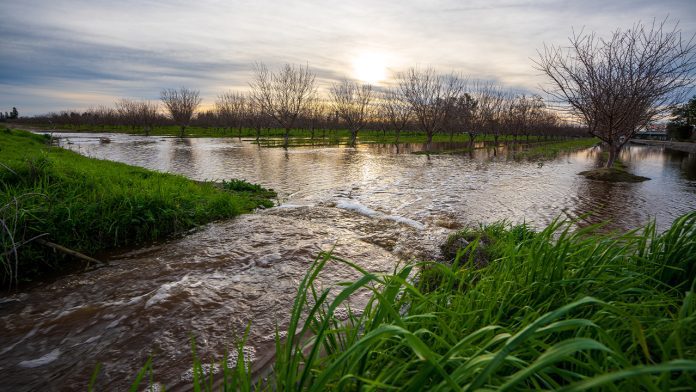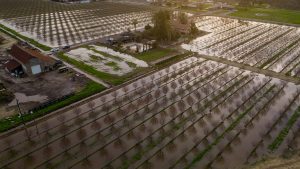
The New Year has ushered in torrential, sustained precipitation for northern and central California. Managing such a large influx of water in a short amount of time has tested California’s infrastructure, municipalities and landowners.
Despite the challenges brought by the current situation, a unique opportunity presents itself for buffering against ongoing and future droughts: Capturing excess flood flows to recharge critically overdrafted groundwater basins. This timely topic, along with updates related to the Sustainable Groundwater Management Act (SGMA) and acute water shortages, were thoroughly discussed by a panel of experts at last month’s 50th Annual Almond Conference.
“It’s difficult to talk about groundwater recharge in a drought year and when you don’t have enough water to irrigate your farms,” said Daniel Mountjoy, director of resource stewardship at Sustainable Conservation. “But we know this is coming. We will see another wet year. If you recall the last wet years of 2017 and 2019, most of us were talking about how much water was being wasted and going down the river to the ocean. The only way to not say that again the next time we have a wet year is to be prepared, and that means getting ready now in the dry years to figure out how you’re going to capture water.”
Recharge Guide Available
To help individual growers prepare for recharge, the Almond Board of California (ABC), in partnership with Sustainable Conservation, recently published a guide titled, “Introduction to Groundwater Recharge.” The easy-to-read resource helps almond growers evaluate their options for conducting groundwater recharge by describing factors to consider and primary recharge methods available, such as:
- Do I have access to surface water for recharge? Growers need to work with local Groundwater Sustainability Agencies (GSAs) and irrigation districts to determine available surface water supplies.
- Is my orchard soil suitable for recharge? Sandy soils are preferred for on-farm recharge as these types of soils rarely become saturated and are less likely to cause harm to crops. UC Davis developed the Soil Agricultural Groundwater Banking Index (casoilresource.lawr.ucdavis.edu/sagbi/) to determine suitability for groundwater recharge on agricultural land. ABC, in partnership with Land IQ, developed an online tool that provides an initial look at site recharge suitability for on-farm recharge.
- What recharge methods are available? Surface applications to orchards, basin and water conveyance structures, and below-the-surface methods are discussed in the guide.
- What orchard management changes are necessary to perform recharge? Consideration of irrigation set-up, field berms and infiltration practices are discussed in the guide.
Coordination Key to Maximizing Recharge Effectiveness
On-farm recharge offers an attractive, cost-effective method for replenishing underground aquifers, Mountjoy noted.
“The most economical way to store water in the state right now is putting water back on the ground and into the aquifer,” he said. “It’s cheaper than districts buying land and building basins; it’s cheaper than building new reservoirs; it’s cheaper than more canals.”
However, on-farm recharge is not as simple as a grower deciding to just do it. Timely capture and movement of surface water for on-farm recharge is largely out of a grower’s hand, requiring action and coordination among several stakeholders off the farm, including irrigation districts, flood managers, GSAs and policymakers.
Sustainable Conservation, along with five GSAs, developed the Groundwater Recharge Assessment Tool (GRAT) to identify and prioritize potential groundwater replenishment options for achieving sustainable groundwater supplies. By combining several factors, such as geology, soil type, crop type, crop timing, costs and delivery systems of water districts, GRAT helps stakeholders assess where, when and how much water can be captured under future water availability scenarios.
“This allows scenario planning to figure out if you divert more water at certain times of year, where can you place it based on the cropping system and agronomic conditions and what will be the cost of alternative solutions,” Mountjoy said.
Using GRAT and other tools that considered the effects of climate change, Sustainable Conservation worked with the California Department of Water Resources on a flood-managed aquifer recharge scenario in the Merced Subbasin. Considering the existing farms with crops and soils compatible with groundwater recharge located in the subbasin, the projected offset of annual groundwater oraft ranges from good to better to best across a variety of scenarios:
- Use of existing conveyance infrastructure and on-farm recharge: 31% of average annual overdraft is recharged;
- Reservoir reoperation (where water is released before storms and captured for recharge) and use of existing conveyance infrastructure and on-farm recharge: 46% of average annual overdraft is recharged;
- Expanded conveyance capacity to floodplain areas that are prone to flooding and reservoir reoperation and on-farm recharge: 63% of average annual overdraft is recharged.
Another benefit to these types of smarter water management decisions is the potential to reduce the impacts of more frequent flood events in the future.
“With the increased storm events that we’re starting to see already, we’re going to see a six-fold increase in flood peaks on the Merced River over the next 30 to 40 years,” Mountjoy said. “With this approach, we can release some of that water, capture it and reduce the flood risk by 65% of what is anticipated.”

Given the current weather conditions, the opportunity for groundwater recharge seems ripe and prudent. For growers with favorable farm conditions and access to water for recharge, more incentive funding programs are becoming available, such as the pilot NRCS groundwater recharge program, grants for land repurposing and local GSA programs.
If your farm isn’t suitable for recharge, that doesn’t mean you can’t participate in advancing the practice of groundwater recharge, Mountjoy noted.
“You should be the one advocating for these regional solutions that benefit us all or supporting policies that allow more water to be diverted at the right time to protect aquatic systems and capture and reduce flood risks.”










